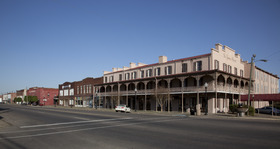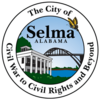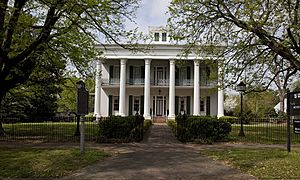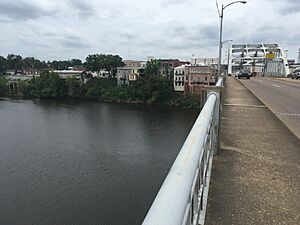Selma, Alabama facts for kids
Quick facts for kids
Selma, Alabama
|
|||
|---|---|---|---|
| City of Selma | |||
|
From top, left to right: St. James Hotel and Water Avenue; Edmund Pettus Bridge; National Voting Rights Museum and Institute
|
|||
|
|||
| Nickname(s):
Queen City of the Black Belt, Butterfly Capital of Alabama
|
|||
| Country | United States | ||
| State | Alabama | ||
| County | Dallas | ||
| Founded | 1815 | ||
| Incorporated | 1820 | ||
| Government | |||
| • Type | Mayor–Council | ||
| Area | |||
| • Total | 14.40 sq mi (37.30 km2) | ||
| • Land | 13.81 sq mi (35.77 km2) | ||
| • Water | 0.59 sq mi (1.54 km2) | ||
| Elevation | 135 ft (41 m) | ||
| Population
(2020)
|
|||
| • Total | 17,971 | ||
| • Density | 1,301.40/sq mi (502.46/km2) | ||
| Demonym(s) | Selmarian | ||
| Time zone | UTC−6 (CST) | ||
| • Summer (DST) | UTC−5 (CDT) | ||
| ZIP Codes |
36701-36703
|
||
| Area code | 334 | ||
| FIPS code | 01-69120 | ||
| GNIS ID | 163940 | ||
Selma is a city in Dallas County, Alabama. It is the main city of the county. Selma is located in the Black Belt region of south central Alabama. It sits along the Alabama River.
In 2020, about 17,971 people lived in Selma. Most of the people living there are African-American.
Long ago, Selma was a busy trading town. It was important for growing cotton. During the Civil War, Selma made many weapons and built warships for the Confederacy. The city was protected by strong walls. However, Confederate forces lost the Battle of Selma near the end of the war.
Today, Selma is famous for its role in the civil rights movement of the 1960s. The Selma to Montgomery marches started here in March 1965. This included "Bloody Sunday," when peaceful marchers were attacked.
By the end of March 1965, about 25,000 people marched to Montgomery. They wanted fair voting rights. This event helped lead to the Voting Rights Act of 1965. This law made sure all Americans could vote.
Selma's population has gone down since the 1960s. This is because farming and factories have changed. Now, the city is focusing on tourism. People visit to learn about its important history in civil rights.
Contents
Selma's Story: A Look at Its Past
Before Europeans arrived, different groups of indigenous peoples lived in the Selma area for thousands of years. Later, the Muscogee people, also known as the Creek, lived here.
French explorers were the first Europeans to visit this area in 1732. They called the spot Écor Bienville. Later, American settlers called it Moore's Bluff. Selma became a city in 1820. William R. King, a politician who later became Vice President, planned and named the city. He named it Selma, which means "high seat" or "throne," from a poem called The Songs of Selma.
Selma During the Civil War
During the Civil War, Selma was a major center for making military supplies. It produced weapons and built warships like the ironclad Tennessee. The iron works in Selma were very important for the South's military. This made Selma a target for Union attacks.
Selma was protected by three miles of strong earth walls. These walls were 8 feet (2.4 m) to 12 feet (3.7 m) high and 15 feet (4.6 m) thick. There was also a ditch and a fence of sharpened posts. Forts with cannons were placed along the walls.
The North knew how important Selma was. They planned to capture the city. Several Union generals tried to reach Selma. But their efforts were stopped before they could get there.
The Battle of Selma

On March 30, 1865, Union General James H. Wilson sent some of his troops to destroy Confederate property. Wilson's forces found messages from Confederate General Nathan Bedford Forrest. These messages showed that Forrest's troops were spread out. Wilson sent more troops to cut off Forrest's reinforcements. A running fight began between Wilson's and Forrest's forces.
On April 1, Wilson's troops met Forrest's line of battle at Ebenezer Church. Forrest had fewer than 2,000 men. Many of them were not experienced soldiers. They were older men and young boys.
The Confederates fought for over an hour. But the Union army had more soldiers and cannons. Forrest was hurt during the fight. Finally, a Union charge broke the Confederate line. Forrest had to retreat.
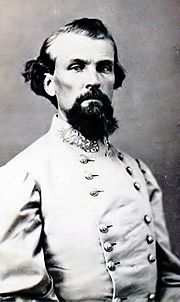
The next morning, Forrest reached Selma. He told General Richard Taylor to leave the city. Taylor left, giving Forrest command of the defense. Selma was protected by strong walls that circled most of the city. The Alabama River protected it on the north and south.
Forrest had less than 4,000 defenders. The walls were built for 20,000 men. So, Forrest's soldiers had to stand far apart to cover the defenses.
Wilson's army arrived at Selma's walls at 2 p.m. He had about 9,000 troops ready to attack.
At 5 p.m., Union General Eli Long decided to attack. His troops charged forward. They were shooting their rifles and supported by cannons. The Confederates fired back with guns and cannons.

The Union soldiers faced many dangers but kept attacking. Once they reached the walls, there was close-up fighting. In less than 30 minutes, Long's men captured the defenses.
General Emory Upton saw Long's success and ordered his troops forward. They also broke through the defenses. Soon, U.S. flags were waving over the walls.
After the outer walls fell, General Wilson led a cavalry charge. But the Confederate forces fired back, and Wilson's horse was hurt. He quickly got back on his horse and ordered more attacks.
Confederate troops also tried to make a stand at the Selma railroad station. The fighting was tough, but the Union army had more soldiers. By 7 p.m., the Union troops had surrounded the Southern positions. The Confederates left the station and the inner walls.
Many Confederate soldiers escaped in the dark. Generals Forrest, Armstrong, and Roddey also got away. Some soldiers swam across the Alabama River to escape.
After the battle, Union troops took things from the city. They destroyed the arsenal and naval factory. Then they left Selma and headed towards Montgomery.
Selma's Location and Size
Selma is located at 32°24′26″N 87°1′16″W / 32.40722°N 87.02111°W. It is west of Montgomery.
The city covers about 14.4 square miles (37 km2). Most of this area is land, and a small part is water.
People of Selma
| Historical population | |||
|---|---|---|---|
| Census | Pop. | %± | |
| 1830 | 401 | — | |
| 1840 | 1,199 | 199.0% | |
| 1850 | 3,073 | 156.3% | |
| 1860 | 3,177 | 3.4% | |
| 1870 | 6,484 | 104.1% | |
| 1880 | 7,529 | 16.1% | |
| 1890 | 7,622 | 1.2% | |
| 1900 | 8,713 | 14.3% | |
| 1910 | 13,649 | 56.7% | |
| 1920 | 15,589 | 14.2% | |
| 1930 | 18,012 | 15.5% | |
| 1940 | 19,834 | 10.1% | |
| 1950 | 22,840 | 15.2% | |
| 1960 | 28,385 | 24.3% | |
| 1970 | 27,379 | −3.5% | |
| 1980 | 26,684 | −2.5% | |
| 1990 | 23,755 | −11.0% | |
| 2000 | 20,512 | −13.7% | |
| 2010 | 20,872 | 1.8% | |
| 2020 | 17,971 | −13.9% | |
| U.S. Decennial Census 2018 Estimate |
|||
Selma's Population in 2020
| Race | Num. | Perc. |
|---|---|---|
| White | 2,573 | 14.32% |
| Black or African American | 14,757 | 82.12% |
| Native American | 26 | 0.14% |
| Asian | 107 | 0.6% |
| Pacific Islander | 6 | 0.03% |
| Other/Mixed | 368 | 2.05% |
| Hispanic or Latino | 134 | 0.75% |
In 2020, there were 17,971 people living in Selma. There were 7,612 households and 4,517 families.
Selma's Population in 2010
In 2010, Selma had 20,756 people. About 80.3% were Black or African American. About 18.0% were White. Other groups made up smaller parts of the population.
Selma's Economy
Selma has several industries. These include International Paper, Bush Hog (farm equipment), and American Apparel. Other companies are Plantation Patterns, Peerless Pump Company, Renasol, and Hyundai.
The city and nearby areas have faced economic challenges. This is because farming jobs have decreased. Also, some industries changed after the 1960s.
Now, tourism related to the civil rights movement is bringing new business to Selma.
Arts and Culture in Selma
Arts Scene


You can enjoy cultural events at the Performing Arts Center. The Selma Art Guild Gallery also shows local art.
Museums and Interesting Places
Selma has many museums. These include Sturdivant Hall, the National Voting Rights Museum, and the Old Depot Museum. You can also visit the Martin Luther King, Jr. Street Historic Walking Tour.
Selma has Alabama's largest historic district. It has over 1,250 important buildings. Other places to visit are Old Live Oak Cemetery and Paul M. Grist State Park. You can also see Old Cahawba Archaeological Park.
The city's history is also seen in its road names. Highway 80 runs through Selma. In 1920, it was named the Jefferson Davis Memorial Highway. Later, parts were named for local leaders. In 1996, it became part of the 'National Civil Rights Trail'. In 2000, sections were renamed to honor civil rights leaders like F.D. Reese, Marie Foster, and Amelia Boynton.
A monument to Confederate General Nathan Bedford Forrest was in Old Live Oak Cemetery. It was removed in 2012. There were plans for a new monument, but some people did not agree with it.
Selma's Library
The Selma-Dallas County Public Library serves the city. It has over 76,000 books. It started as a Carnegie library in 1904. The library building is 25,000 square feet (2,300 m2) and is in downtown Selma.
Getting Around Selma
Selma is served by several main roads:
Airports Near Selma
- Craig Field (SEM) is an airport located about four nautical miles (4.6 mi; 7.4 km) southeast of Selma's city center.
Learning in Selma
Colleges and Universities
Selma has a few colleges. These include Selma University and Wallace Community College Selma. Concordia College Alabama, a private Lutheran university, was in Selma from 1922 to 2018.
Public Schools
Selma City Schools runs the public schools in the city. The public high school is Selma High School. Middle schools are R.B. Hudson Middle School and the School of Discovery. Selma also has eight elementary schools.
Private Schools
Selma has four private K-12 schools. These are John T. Morgan Academy, Meadowview Christian School, Ellwood Christian Academy, and Cathedral Christian Academy.
Media in Selma
Selma gets its TV service from the Montgomery-Selma television area. You can get cable TV from Charter Communications. Satellite TV is available from DirecTV and Dish Network.
Radio Stations
- WALX 100.9 FM (Classic Hits)
- WAPR 88.3 FM (Educational)
- WAQU 91.1 FM (Christian)
- WDXX 100.1 FM (Country music)
- WHBB 1490 AM (News/Talk/Gospel)
- WJAM 1340 AM/96.3 FM (Urban adult contemporary)
- WRNF 89.5 FM (Religious)
- WBFZ 105.3 FM (Gospel Blues R&B Talk)
Television Stations
- WAKA (Channel 8) CBS
- WBIH (Channel 29) Independent
Newspapers
- Selma Times-Journal (daily newspaper)
- Selma Sun (weekly newspaper)
Famous People from Selma
- Zinn Beck – A baseball player and manager.
- Ann Bedsole – The first woman to be in the Alabama Senate.
- Jo Bonner – A U.S. Representative for Alabama.
- Edgar Cayce – A famous psychic who lived in Selma.
- J.L. Chestnut – An author and civil rights activist.
- Jim Clark – A sheriff during the 1960s civil rights movement.
- Mattie Moss Clark – A gospel music artist.
- Annie Lee Cooper – A civil rights activist.
- Charles Davis – A basketball player for Azerbaijan's national team.
- Howard W. Gilmore – A World War II submarine commander who received the Medal of Honor.
- Mia Hamm – A famous soccer player and Olympic gold medalist.
- Jeremiah Haralson – A former slave who became a U.S. Representative.
- Sam Hobbs – A U.S. Representative.
- Eunice W. Johnson – The founder of the Ebony Fashion Fair.
- Michael Johnson – A National Football League player.
- James Ralph "Shug" Jordan – A head football coach for Auburn University.
- William Rufus King – A U.S. Senator and Vice President of the United States.
- Terry Leach – A Major League Baseball player.
- Bogart Leashore – A social worker and dean at Hunter College.
- William Clarence Matthews – A baseball player, coach, and civil rights activist.
- Darrio Melton – A former Mayor of Selma.
- Johnny Moore – The lead singer for The Drifters.
- Ben Obomanu – A National Football League player.
- James Perkins, Jr. – The first African American mayor of Selma.
- Edmund Pettus – A U.S. Senator and Confederate General.
- Minnie Bruce Pratt – An educator and activist.
- Frederick D. Reese – A civil rights movement leader.
- Amelia Boynton Robinson – A civil rights movement leader.
- Richard Scrushy – The founder of HealthSouth.
- Jeff Sessions – A U.S. Senator and Attorney General.
- Terri Sewell – A U.S. Representative for Alabama.
- Lachavious Simmons – A National Football League player.
- Benjamin S. Turner – The first African American U.S. Representative from Alabama.
- Hattie Hooker Wilkins – The first woman elected to the Alabama Legislature.
- Kathryn Tucker Windham – A storyteller, author, and photographer.
- Asher HaVon – A singer who won The Voice.
Sports in Selma
Selma's Bloch Park was once home to the Selma Cloverleafs, a professional baseball team.
See also
 In Spanish: Selma (Alabama) para niños
In Spanish: Selma (Alabama) para niños


